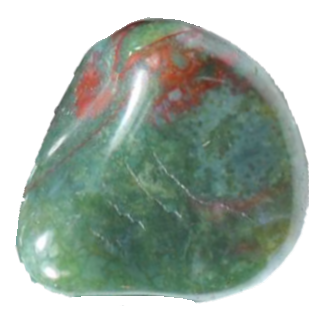
The mineral more commonly known as Bloodstone is an aggregate officially called Heliotrope, derived from the Greek hḗlios (Sun) and trépein (to turn). It is a mixture of quartz that occurs mostly as jasper (opaque) or sometimes as chalcedony (translucent). The “classic” Bloodstone is opaque green jasper with red inclusions of hematite. The red inclusions may resemble spots of blood, hence the name Bloodstone. It is also sometimes referred to as Christ’s Stone due to its association with Christian lore.
Composition, Physical Characteristics, and Varieties
Bloodstone is a dark green variety of chalcedony, a cryptocrystalline quartz, with distinctive red inclusions of iron oxide or jasper. It has a hardness of 6.5 to 7 on the Mohs scale and exhibits a smooth, waxy lustre. There are two primary varieties:
- Classic Bloodstone – Deep green with prominent red speckles.
- Plasma – A deeper green variety with little or no red inclusions.
Geographical Locations
Significant deposits of Bloodstone are found in:
- India (notably in Gujarat)
- Brazil
- Australia
- China
- Madagascar
- United States (California and Oregon)
- Scotland
Archaeological and Significant Finds
Bloodstone has been used for centuries in seals, signet rings, and carved amulets. Ancient Mesopotamians and Greeks valued it for its ability to enhance strength and resilience. In the Middle Ages, Bloodstone was frequently carved into religious artefacts, including depictions of Christ’s crucifixion.
The ancient Greeks and Romans wore the stone to bring fame and fortune and to protect against the bite of venomous creatures. Their athletes used it as a lucky charm to bring victory in the games. Ancient Roman soldiers believed the stone had the ability to slow bleeding and wore it for this reason.
Similarly, Asian Indian people have the same belief that it could staunch bleeding. They would cool the stone in cold water and place it on wounds. Naturally, cold and pressure stop bleeding, and the stone contains iron oxide, an effective astringent. In Indian culture, Bloodstone is also considered an aphrodisiac.
The Leyden Papyrus, written in Greek in the 3rd century CE, states that Bloodstone will give the wearer whatever he may ask for and “whatever thou wearer says, he will be believed. Whoever bears this stone, which is a gem, and pronounces the name engraved upon it, will find all doors open, while bonds and stone walls will rent asunder.”
Heliotrope was believed to have very bizarre magical properties. The Roman historian Pliny the Elder wrote that magicians used it as a stone of invisibility. Damigeron wrote about its properties to make rain, cause solar eclipses, and its special virtue in divination and preserving health and youth.
Ground, powdered, and mixed with honey, Bloodstone was used to cure tumours, draw out snake venom, and staunch haemorrhages. It was said to clear putrefaction of abscesses in a day, and simply looking at the Bloodstone was believed to prevent eye diseases.
Historical and Current Usage
Historically, warriors carried Bloodstone for protection and to staunch wounds. It was also ground into powder and mixed with honey as an elixir. Ancient Egyptians believed it could provide strength and power, often using it in statues and carvings of their gods. Bloodstone was also linked to the Crusaders, who believed it could bring victory in battle.
Throughout history, Bloodstone has been associated with medical practices. Medieval physicians prescribed it to halt haemorrhaging and aid circulation, while Renaissance alchemists incorporated it into potions intended to enhance vitality and longevity. In India, finely ground Bloodstone was sometimes applied as a traditional remedy for snake bites and venomous stings.
Today, it is popular in jewellery, meditation tools, and holistic healing practices. Many still regard it as a protective stone, using it in energy work and spiritual healing.
Interesting Facts
- When placed into water, Bloodstone can add a reddish hue that intensifies when exposed to sunlight.
- Bloodstone was believed to grant invisibility when held in the mouth.
- Ancient alchemists used it to prolong youth and vitality.
- It was historically crushed and used as a pigment in artworks.
- Some medieval monks carried Bloodstone rosaries, believing they could ward off disease and enhance piety.
Folklore, Legends, and Tales
A Christian story states that during the crucifixion, Jesus was stabbed in the side by a Roman soldier, and that his blood falling on the stone gives it the red flecks.
Greek and Roman myths tell of warriors embedding Bloodstone into their armour and weapons to grant them divine protection. In Persian folklore, Bloodstone was said to harness the power of the storm god and could summon rain during droughts. During the Middle Ages, it was thought that placing Bloodstone under a pillow could prevent nightmares and ensure restful sleep.
Mystical Healing Properties
Bloodstone is revered for its physical and emotional healing properties:
- Physical Healing – Supports circulation, boosts immunity, and aids in detoxification.
- Emotional Healing – Enhances resilience, dispels negative energy, and fosters courage.
- Spiritual Healing – Strengthens intuition and aligns the body’s energy field.
Wear or carry Bloodstone to increase mental clarity and to aid in decision-making. It provides a mental boost when motivation is lacking and can revitalise the mind and body if you are exhausted.
Astrology and Zodiac Links
Bloodstone is associated with Aries, enhancing courage, vitality, and determination. It also resonates with Pisces, balancing their emotional depths with grounding energy.
Chakra System Connections
Bloodstone primarily aligns with the Root Chakra, promoting stability and strength, while also stimulating the Heart Chakra, encouraging emotional balance and courage.
Birthstone and Wedding Anniversary Link
Bloodstone is a traditional birthstone for March, offering strength and vitality. It is also associated with the 14th wedding anniversary, symbolising resilience and renewal in relationships.
